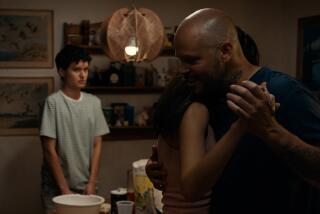He’s in the Details : MARINE LIFE <i> By Linda Svendsen (Farrar Straus Giroux: $18; 162 pp.)</i>
God must have loved the common people, Lincoln said, because He made so many of them. Which sounds good, but how did He go about it? Loving them, that is.
Authors, gods to their characters, suggest the same question. How to write about the ordinary lives of ordinary people and, without employing extremities of plot or style, make them precious and irreplaceable? Not many contemporary authors care to, in fact; or can.
When they do, though, the trick, which is ultimately mysterious, lies in the minute workings of language. Just as a photographer’s art lies in an instinct for the gradations of light--a tiny shift makes the difference between a photograph of a commonplace that is remarkable and one that is commonplace--it is the exact angle of a phrase that makes a plain life live.
There is nothing out of the ordinary about the Vancouver family of Adele Nordstrom, narrator of the eight linked stories that make up Linda Svendsen’s “Marine Life.” June, her mother, is a little flighty; she had three marriages; the last quite happy to a man six years younger. Adele’s brother, Ray, sparkled a bit when young, but has grown into a depressive middle-age as a longshoreman. Joyce, a sister, is settled after an initially troubled marriage and a breakdown. Irene, the other sister, has lived a deliberately orderly life with a demanding husband. At the end of the 30 years that “Marine Life” covers, she will have cancer and her pudgy, unhappy daughter will have committed suicide. A tragedy, but of a kind that happens to the neighbors down the street.
Nothing distinctive, in short, until you get to the details. God is in them, as the saying goes, and specifically, Svendsen’s Adele tells of her mother, brother, sisters, father and stepfather with such fresh precision that her sentences adopt us. They pull us into the family, though we see it more clearly than any family member can. Which is why we require books as well as brothers.
Most of the stories focus on one particular family member, though it is always as a leading voice in a counterpoint; the other voices are woven in. Adele, growing and changing, is present throughout, and so is her mother. June’s restlessness and her piano-playing bestow upon the children twin marks of the transitory: the pain in it, and the beauty. The two are joined in a childhood memory of lying under the piano and seeing June’s feet “nodding on the peddles”).
Ray’s story tells of his erratic wanderings among women. Is the restlessness related to June’s? (“In 1959, Ray was 19 and two fathers wiser.”) It is a possibility, barely suggested. Svendsen rarely asserts; if her characters are so rounded, it is because they are modeled with shadows and silence.
There is Velma, on whom Ray’s restlessness inflicts an almost unnoticeable violence during a beach expedition; and Dallyce, who can take care of herself and won’t stick around long. There is Merrie, whom he briefly marries and who goes from cute to insanely jealous. When she gets pregnant she accuses Ray of arranging it so he can see other women; when she miscarries, she takes a taxi to the ship he is loading, and hurls the baby’s layette into the hold.
That is a rare bit of colorful extremity. Another comes when June, still married to her second husband, Adele’s father, takes her to the beach on an outing with Robert, whom she will marry. Adele is 6; so is Robert’s daughter Louise. A railroad line runs nearby; Adele lies down on it and persuades Louise to do the same. They are pulled off just before a train goes by. In another moment of extremity, Adele, 12, is doing the housework with Joyce, dangerously depressed by her strained marriage. Joyce suddenly raises the vacuum-cleaner nozzle to the bird cage, and sucks up the finch. She will go to a hospital, but return and gradually take up her life.
Such moments are exceptional. They are telling, but mainly insofar as they flag the deeper movements underneath. They are necessary--it would be excessively melodramatic to render a family entirely without melodrama--but the book’s real power and excitement come in its quieter transactions.
Ray’s adventures, for example, serve as a means of portraying Adele’s growing awareness of time and loss. As a child, she worshiped him and begged to stay up late with him. When he visits her later on--he is in his 40s; she is in her 30s, divorced and with two children--it is he who wants to stay up, while she wants to go to sleep.
More moving than Joyce’s moment of breakdown is an earlier scene. Adele bicycles home in the evening full of a 12-year-old’s boisterousness. She is stopped short by the sight of Joyce standing there with June. Joyce is leaving her husband, June announces, and breaks off to put away the lawnmower. “She called over the rattle, ‘Doesn’t the grass smell good?’ and disappeared into the garage. She was crying.”
After Adele’s railroad-track escapade comes the beautifully told story of Louise, her father now married to June, growing up stormily, sometimes with the family and sometimes off on her own. As she and Adele mature, their own relationship is by turns combative and close. Grown, battered in various ways and with the comradeship of veterans, they go swimming. “We sat holding hands until she stood, and I got up too, then walked over the sand into the warm water and went under. For those wonderful seconds, we’d never been born.”
The one truly tragic story is that of Irene, who loses both her health and her daughter in her obsessively childlike subservience to a neurotic husband. It is told in muted tones whose power accumulates imperceptibly.
There is a tender but stoical scene of closeness between Adele, who comes home pregnant for a visit, and June, who has grown old and directs her restlessness into learning how to swim. There is a comically melancholy portrait of Adele’s wood-cutter father, whom June left for his excessive stolidity.
The book is lightened by two kind and patient men: Adele’s step-father, and her meteorologist husband. Their courtship is marked by her jealous insecurity--we know where that came from, but Svendsen doesn’t tell us--and his persistent devotion. “I’ll always love you,” he tells her. “We’ll be unhappy forever.” It is a remarkably winning proposal; it wins Adele. They are not unhappy forever, as it turns out; eventually they split up. But nothing in life can last, of course, and “Marine Life’s” only forever is its wonderful way with transience.
More to Read
Sign up for our Book Club newsletter
Get the latest news, events and more from the Los Angeles Times Book Club, and help us get L.A. reading and talking.
You may occasionally receive promotional content from the Los Angeles Times.






